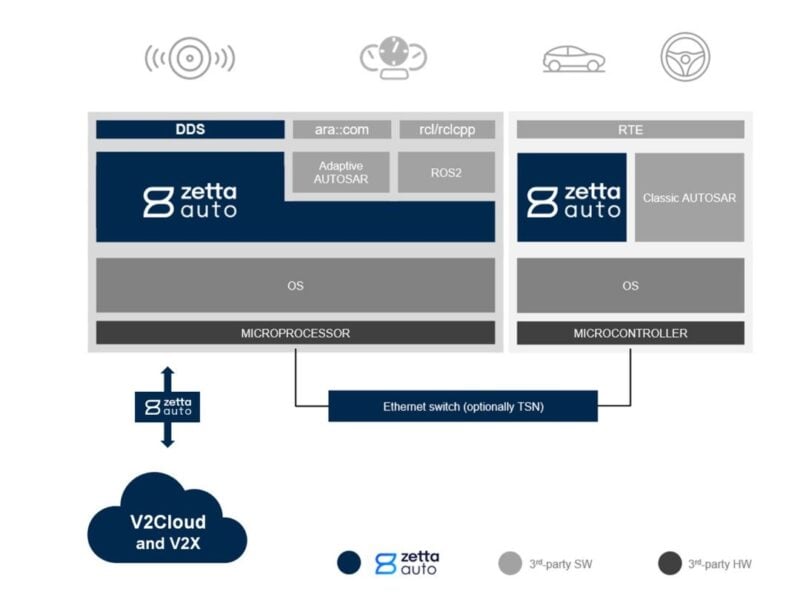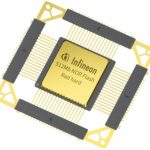
TTTech Auto teams for safety critical software defined vehicles
TTTech Auto is working with ZettaScale Technology on for integrated safety critical technology in software defined vehicles.
A safety-certified in-vehicle unified communication platform from the two initially focusses on Service-Oriented Architecture (SOA) communication from microcontrollers to the cloud for the updates and needed for software defined vehicles. This could also be extended to V2X external links to infrastructure and other vehicles at a later date.
Zetta Auto combines Data Distribution Service (DDS) publish-subscribe technology with Time Sensitive Networking (TSN) and the Zenoh publish/subscribe/query open source protocol to ASIL-D levels of safety.
- The new generation of software-defined vehicles
- Renault, Valeo team up for the software-defined vehicles
“We are developing this product and strengthening the partnership with Zetta,” said Clemens Heller, product manager for Zetta Auto at TTTech Auto.
“Our main goal is contributing to making service oriented architectures a safe reality. In software defined vehicles you need to abstract the hardware from the software and have ease of use while still putting things together that work and are safe.”
“DDS is proven in other industries and has found its way to automotive so with Zetta Auto we are making it a more integrated unified product for in-vehicle communications and lays the foundation for V2X,” he said.
Zetta are the maintainer of the Eclipse Cyclone project and TTech has been working with them on safe automotive software development to rework the Cyclone open core to be certified to the ASIL-D level of safety. Adding TSN, developed by TTTech, adds real time Ethernet capability, and this is combined with the quality of service (QoS) priorities in DDS to ensure that time critical data is delivered with a known latency.
Safety critical communications
“We see Ethernet with TSN as the right technology and this fits nicely with DDS with the QoS. We test and integrate Cyclone DDS with TSN and bring the TSN planning tool to configure the whole TSN network,” said Heller.
The in-vehicle integration uses the Zenoh protocol, also developed by the Eclipse project and written in the Rust language to handle data in embedded systems and queries in the cloud transparently.
“The main way it provides the responsiveness is by being resource efficient as it has a low overhead across the medium and it is flexible about where you put the data, so with integration you can put data close to where it is required at the edge and make it easy for users to integrate,” said Heller.
TTech is also using a different implementation of the Zenoh protocols called pico Zehoh and written in C for microcontrollers. This will be used to implement DDS for AutoSAR Classic for ASIL-D safety certification in software defined vehicles.
“The pico version is optimised for a small footprint and is written in C for microcontrollers,” said Heller. “We want to make it easy to access DDS data through AutoSAR APIs so with the integrated Zehoh pico this seamlessly integrated with DDS in the microcontroller, they don’t need to configure much more and this will be available for ASIL-D.”
ASIL-D certification
Ensuring the software is safe is key, but the integrated APIs can help with the system-level certification.
“There are a couple of aspects to the certification,” said Heller. “The first step is to define all the failure modes and these we cover in different ways, through the code quality, end to end protection with the integrated APIs so any lost data is known. Then to ensure the ASIL-D communications we are implementing TTTech shared memory into Cyclone to ensure the SAIL-D is not impacted by other applications,” he explained.
DDS for V2X
The V2X implementation will build on the in-vehicle software development for software defined vehicles but not with ASIL-D certification.
“For us, what we see it is important that you have a unified underpinning for all the communication needs in the software defined vehicle, then building on that and integrating Zenoh. It is a natural transition to V2X so its looks like one solution,” he said.
“We have the DDS integration now with microcontrollers and you could see that as well for V2X. We do not have this right now but applications can use Zenoh APIs directly to talk directly to the cloud, so developers don’t have to know where the data is. Making data available through other [data] APIs such as MQTT is possible.”
“For us there are benefits in having integration with the infrastructure telecoms providers at the edge though 5G, so it’s not about specific links.”
The details of Zetta Auto are at https://www.tttech-auto.com/sites/default/files/2023-07/Zetta_Auto_Data-Sheet_ENG%20%282%29_0.pdf
 If you enjoyed this article, you will like the following ones: don't miss them by subscribing to :
eeNews on Google News
If you enjoyed this article, you will like the following ones: don't miss them by subscribing to :
eeNews on Google News






